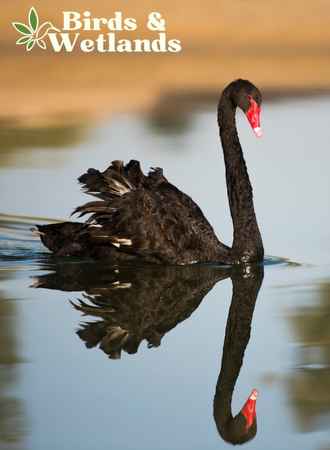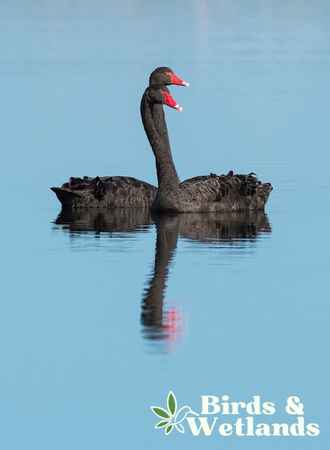Swans are large water birds with long necks and bodies. They are known for their snow-white plumage, which is why they are often associated with grace and beauty. But do black swans exist?
While the image of a swan is often synonymous with the color white, it is important to note that there is a black swan species – the black swan (Cygnus atratus). These birds have black feathers and red beak and are native to Oceania and found throughout Australia and New Zealand.
Prior to the arrival of European explorers in Australia, it was widely believed that only white swans existed.
Key Takeaways on Black Swan
- Black swans are mostly black except for the white flight feathers.
- The black swan feed on aquatic and marshland plants, supplementing its diet with small fish and aquatic invertebrates.
- The juvenile plumage of immature birds is mostly gray.
- During molting, black swans lose their flight feathers.
- Outside of Australia and New Zealand, black swans are considered an introduced species. These swans managed to escape and form stable populations.
- Black swans are nomadic with no set migratory pattern.
What are black swans?
The black swan is almost identical in appearance as the white swan except for the color of its plumage and slower wing beat. The white swan has white feathers while the black swan has mostly black plumage. It has a sleek and elegant appearance, with a long, curved neck and a broad, flat bill.
The wings of the black swan are mostly black with broad white wing tips visible in flight, creating a striking contrast. It greyish-black legs and feet.
The bill of the black swan is deep orange-red or bright red and has a distinct narrow white band near the tip, which stands out against the black plumage and adds to the overall striking appearance of the bird.
Adult males have a longer and straighter bill and are slightly larger than adult females.
A young black swan has a gray plumage and black wing tips.

Where do Australian black swans live?
The black swan is commonly found in wetlands, lakes, lagoons, rivers, and coastal waters of southern Australia for food and nesting materials.
During the breeding season, they prefer large, permanent bodies of fresh or brackish water with plenty of aquatic vegetation for grazing. They are attracted to areas with abundant food sources, such as aquatic plants and invertebrates like mollusks and worms.
Some black swans nest in freshwater wetlands, particularly areas with reed beds or dense aquatic vegetation for nesting.
The black swan is a highly nomadic species with irregular and erratic migration patterns dependent on weather conditions. In the summer, they can be found in inland wetlands and billabongs, where food resources such as insects, crustaceans, and mollusks are more abundant.
When winter comes, young and adult black swans move towards nutrient-rich waterways such as coastal estuaries to find a more varied diet, including seagrasses and marine animals.
During droughts, these birds tend to congregate around remaining permanent shallow water, forming large flocks comprising several hundred individuals.
In addition to their various wetland habitats, black swans are also known to inhabit agricultural land near waterways. These areas are abundant in irrigated pasture or crop fields, providing them with an easy source of food, including cereal grains, roots, and other crops that might have been spilled onto the ground during harvesting operations.
What do black swans eat?
The diet of the black swan primarily consists of aquatic plants such as cattails, watermilfoils, widgeonweeds, algae, and pondweeds. They also supplement their diet with small animals such as worms, insects, snails, small fish, mollusks, and aquatic invertebrates.
The bird obtains its food by plunging its neck underwater or dabbling on the water’s surface.
Black swans also practice upending, which involves submerging themselves completely underwater with their tails in the air to search for food deeper down. This technique is done by swimming with their heads upside-down, searching for food items at the bottom of rivers or lakes.
Black swans have long necks, which allow them to reach further under rocks and other hard-to-reach spots where animals are likely hiding from predators. Their long bills also aid in grasping food from the depths below them.
Furthermore, black swans are well-adapted to take advantage of food sources within wetlands by using their strong webbed feet to paddle through the water and walk on muddy surfaces near marshes or ponds.
Black swans are gregarious birds, often observed forming flocks with other swans when seeking out food together in groups during certain times of the year. For instance, many black swans forage food together when raising chicks that need extra nourishment or during seasonal migrations when sustenance may be scarce due to weather conditions.

What is the natural range and distribution of the Australian black swan?
The black swan is a species native to the southeast and southwest regions of the country, where it is most commonly found. It mostly occurs in the wetlands of western and eastern Australia. It is an uncommon sighting in other parts of Australia, except for the Cape York Peninsula region.
As a popular ornamental bird in many bird collections, black swans have established small breeding populations outside of Australia, such as in the United Kingdom, Japan and China. In addition, feral populations have been breeding in southern Florida, USA for a few years now.
What are the reproduction and nesting habits of the black swans?
The black swan is a large bird with an iconic status in its native range. As the state’s official bird, the black swan is featured in the state flag and coat of arms of Western Australia. It is also the namesake of Swan river.
The black swan typically breeds during high water levels, which can occur in February in northwest Australia or August in western regions.
The black swan nests in loose companies numbering into the hundreds or pairs near the water’s edge, using riverine vegetation or islets, and construct nests with twigs, stems, sticks, and grass bound together with mud. In some cases, the nest can be seen floating in deeper water.
The female black swan lays 5-6 greenish eggs, which take 36-40 days to incubate, after which the baby swans are precocial and able to feed and swim shortly after hatching. The fledging period of the black swan is 150-170 days after hatching.
In addition to providing protection, members of a colony may engage in mutual preening activities to build trust and strengthen social ties, which helps reduce conflicts during breeding seasons when competition for resources can be an issue among neighbors.
Like most swans, the black swans molt and lose their flight feathers for about a month. During this time, the adult black swan becomes defenseless against predators.
The black swan is not considered threatened species and is listed as Least Concern. It is a protected under the National Parks and Wildlife Act in New South Wales.

What is the black swan theory?
The black swan theory, also known as the theory of black swan events, refers to a metaphor that describes an occurrence that is unexpected and has a significant impact. These events are often retrospectively rationalized with the benefit of hindsight.
The term originates from an old saying that assumed black swans did not exist, which is similar to the idea that these rare and unpredictable events were thought to be impossible before they occurred. The black swan was once considered a rare bird.
What do black swans sound like?
Black swans emit softer crooning notes. They are also known for making whistling sounds. Younger birds or young cygnets are mostly silent.


